Applied Research BMG827: Task 1 - Qualitative Observation Analysis
VerifiedAdded on 2023/01/12
|16
|6599
|58
Report
AI Summary
This report delves into the realm of observation as a qualitative research method, meticulously examining its core purpose and outlining its advantages and disadvantages in the context of data collection. It explores four key dimensions that distinguish various observational approaches, providing a comprehensive understanding of the diverse methodologies employed. The report then addresses the critical issue of observer bias, dissecting its potential causes and presenting practical strategies for minimizing its impact on research outcomes. Finally, it offers a critical evaluation of the ethical considerations surrounding the use of concealed observation, analyzing the potential conflicts between research objectives and the rights of research participants. The report aims to provide a thorough analysis of observation as a research tool.

APPLIED RESEARCH
Paraphrase This Document
Need a fresh take? Get an instant paraphrase of this document with our AI Paraphraser
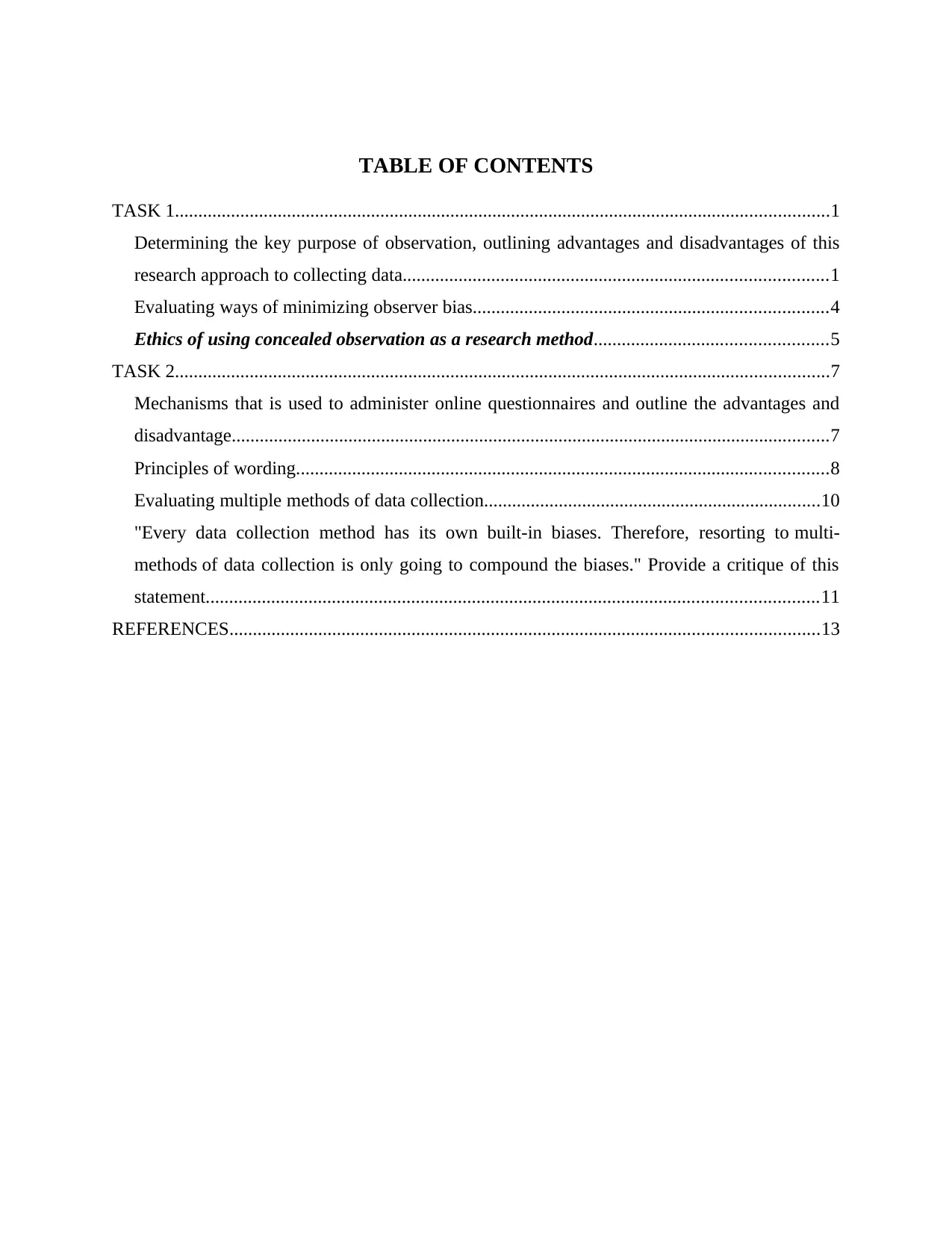
TABLE OF CONTENTS
TASK 1............................................................................................................................................1
Determining the key purpose of observation, outlining advantages and disadvantages of this
research approach to collecting data...........................................................................................1
Evaluating ways of minimizing observer bias............................................................................4
Ethics of using concealed observation as a research method..................................................5
TASK 2............................................................................................................................................7
Mechanisms that is used to administer online questionnaires and outline the advantages and
disadvantage................................................................................................................................7
Principles of wording..................................................................................................................8
Evaluating multiple methods of data collection........................................................................10
"Every data collection method has its own built-in biases. Therefore, resorting to multi-
methods of data collection is only going to compound the biases." Provide a critique of this
statement...................................................................................................................................11
REFERENCES..............................................................................................................................13
TASK 1............................................................................................................................................1
Determining the key purpose of observation, outlining advantages and disadvantages of this
research approach to collecting data...........................................................................................1
Evaluating ways of minimizing observer bias............................................................................4
Ethics of using concealed observation as a research method..................................................5
TASK 2............................................................................................................................................7
Mechanisms that is used to administer online questionnaires and outline the advantages and
disadvantage................................................................................................................................7
Principles of wording..................................................................................................................8
Evaluating multiple methods of data collection........................................................................10
"Every data collection method has its own built-in biases. Therefore, resorting to multi-
methods of data collection is only going to compound the biases." Provide a critique of this
statement...................................................................................................................................11
REFERENCES..............................................................................................................................13
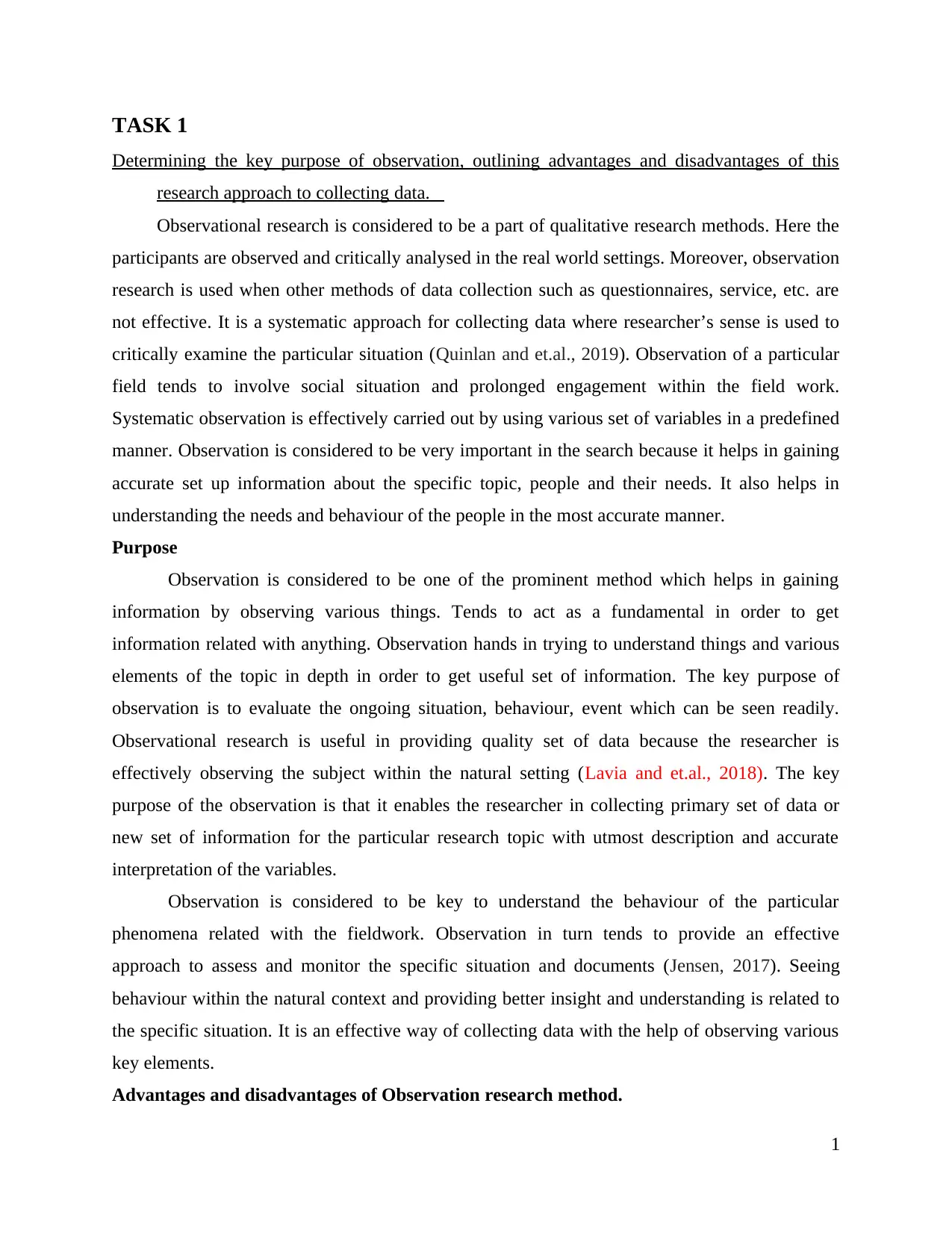
TASK 1
Determining the key purpose of observation, outlining advantages and disadvantages of this
research approach to collecting data.
Observational research is considered to be a part of qualitative research methods. Here the
participants are observed and critically analysed in the real world settings. Moreover, observation
research is used when other methods of data collection such as questionnaires, service, etc. are
not effective. It is a systematic approach for collecting data where researcher’s sense is used to
critically examine the particular situation (Quinlan and et.al., 2019). Observation of a particular
field tends to involve social situation and prolonged engagement within the field work.
Systematic observation is effectively carried out by using various set of variables in a predefined
manner. Observation is considered to be very important in the search because it helps in gaining
accurate set up information about the specific topic, people and their needs. It also helps in
understanding the needs and behaviour of the people in the most accurate manner.
Purpose
Observation is considered to be one of the prominent method which helps in gaining
information by observing various things. Tends to act as a fundamental in order to get
information related with anything. Observation hands in trying to understand things and various
elements of the topic in depth in order to get useful set of information. The key purpose of
observation is to evaluate the ongoing situation, behaviour, event which can be seen readily.
Observational research is useful in providing quality set of data because the researcher is
effectively observing the subject within the natural setting (Lavia and et.al., 2018). The key
purpose of the observation is that it enables the researcher in collecting primary set of data or
new set of information for the particular research topic with utmost description and accurate
interpretation of the variables.
Observation is considered to be key to understand the behaviour of the particular
phenomena related with the fieldwork. Observation in turn tends to provide an effective
approach to assess and monitor the specific situation and documents (Jensen, 2017). Seeing
behaviour within the natural context and providing better insight and understanding is related to
the specific situation. It is an effective way of collecting data with the help of observing various
key elements.
Advantages and disadvantages of Observation research method.
1
Determining the key purpose of observation, outlining advantages and disadvantages of this
research approach to collecting data.
Observational research is considered to be a part of qualitative research methods. Here the
participants are observed and critically analysed in the real world settings. Moreover, observation
research is used when other methods of data collection such as questionnaires, service, etc. are
not effective. It is a systematic approach for collecting data where researcher’s sense is used to
critically examine the particular situation (Quinlan and et.al., 2019). Observation of a particular
field tends to involve social situation and prolonged engagement within the field work.
Systematic observation is effectively carried out by using various set of variables in a predefined
manner. Observation is considered to be very important in the search because it helps in gaining
accurate set up information about the specific topic, people and their needs. It also helps in
understanding the needs and behaviour of the people in the most accurate manner.
Purpose
Observation is considered to be one of the prominent method which helps in gaining
information by observing various things. Tends to act as a fundamental in order to get
information related with anything. Observation hands in trying to understand things and various
elements of the topic in depth in order to get useful set of information. The key purpose of
observation is to evaluate the ongoing situation, behaviour, event which can be seen readily.
Observational research is useful in providing quality set of data because the researcher is
effectively observing the subject within the natural setting (Lavia and et.al., 2018). The key
purpose of the observation is that it enables the researcher in collecting primary set of data or
new set of information for the particular research topic with utmost description and accurate
interpretation of the variables.
Observation is considered to be key to understand the behaviour of the particular
phenomena related with the fieldwork. Observation in turn tends to provide an effective
approach to assess and monitor the specific situation and documents (Jensen, 2017). Seeing
behaviour within the natural context and providing better insight and understanding is related to
the specific situation. It is an effective way of collecting data with the help of observing various
key elements.
Advantages and disadvantages of Observation research method.
1
⊘ This is a preview!⊘
Do you want full access?
Subscribe today to unlock all pages.

Trusted by 1+ million students worldwide
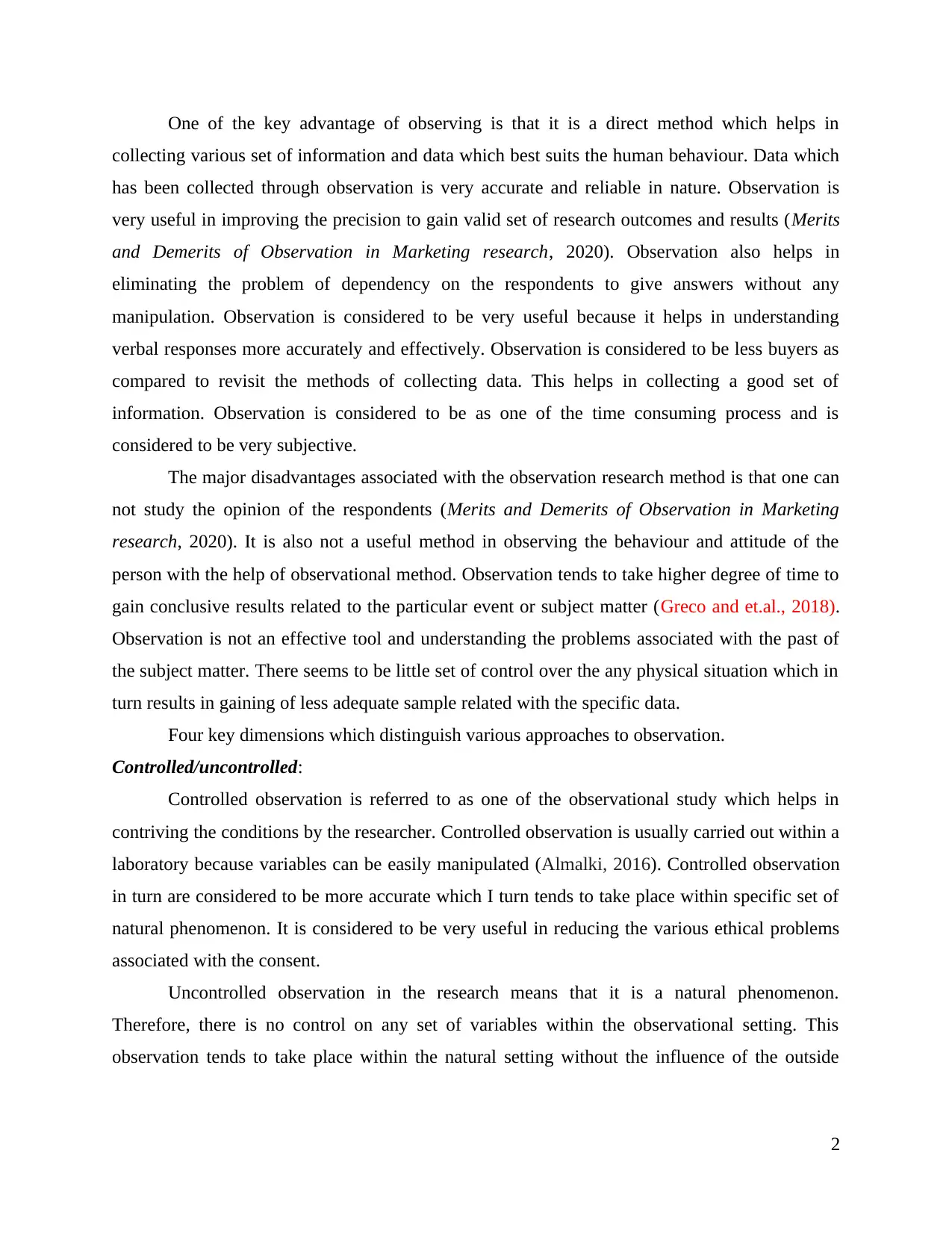
One of the key advantage of observing is that it is a direct method which helps in
collecting various set of information and data which best suits the human behaviour. Data which
has been collected through observation is very accurate and reliable in nature. Observation is
very useful in improving the precision to gain valid set of research outcomes and results (Merits
and Demerits of Observation in Marketing research, 2020). Observation also helps in
eliminating the problem of dependency on the respondents to give answers without any
manipulation. Observation is considered to be very useful because it helps in understanding
verbal responses more accurately and effectively. Observation is considered to be less buyers as
compared to revisit the methods of collecting data. This helps in collecting a good set of
information. Observation is considered to be as one of the time consuming process and is
considered to be very subjective.
The major disadvantages associated with the observation research method is that one can
not study the opinion of the respondents (Merits and Demerits of Observation in Marketing
research, 2020). It is also not a useful method in observing the behaviour and attitude of the
person with the help of observational method. Observation tends to take higher degree of time to
gain conclusive results related to the particular event or subject matter (Greco and et.al., 2018).
Observation is not an effective tool and understanding the problems associated with the past of
the subject matter. There seems to be little set of control over the any physical situation which in
turn results in gaining of less adequate sample related with the specific data.
Four key dimensions which distinguish various approaches to observation.
Controlled/uncontrolled:
Controlled observation is referred to as one of the observational study which helps in
contriving the conditions by the researcher. Controlled observation is usually carried out within a
laboratory because variables can be easily manipulated (Almalki, 2016). Controlled observation
in turn are considered to be more accurate which I turn tends to take place within specific set of
natural phenomenon. It is considered to be very useful in reducing the various ethical problems
associated with the consent.
Uncontrolled observation in the research means that it is a natural phenomenon.
Therefore, there is no control on any set of variables within the observational setting. This
observation tends to take place within the natural setting without the influence of the outside
2
collecting various set of information and data which best suits the human behaviour. Data which
has been collected through observation is very accurate and reliable in nature. Observation is
very useful in improving the precision to gain valid set of research outcomes and results (Merits
and Demerits of Observation in Marketing research, 2020). Observation also helps in
eliminating the problem of dependency on the respondents to give answers without any
manipulation. Observation is considered to be very useful because it helps in understanding
verbal responses more accurately and effectively. Observation is considered to be less buyers as
compared to revisit the methods of collecting data. This helps in collecting a good set of
information. Observation is considered to be as one of the time consuming process and is
considered to be very subjective.
The major disadvantages associated with the observation research method is that one can
not study the opinion of the respondents (Merits and Demerits of Observation in Marketing
research, 2020). It is also not a useful method in observing the behaviour and attitude of the
person with the help of observational method. Observation tends to take higher degree of time to
gain conclusive results related to the particular event or subject matter (Greco and et.al., 2018).
Observation is not an effective tool and understanding the problems associated with the past of
the subject matter. There seems to be little set of control over the any physical situation which in
turn results in gaining of less adequate sample related with the specific data.
Four key dimensions which distinguish various approaches to observation.
Controlled/uncontrolled:
Controlled observation is referred to as one of the observational study which helps in
contriving the conditions by the researcher. Controlled observation is usually carried out within a
laboratory because variables can be easily manipulated (Almalki, 2016). Controlled observation
in turn are considered to be more accurate which I turn tends to take place within specific set of
natural phenomenon. It is considered to be very useful in reducing the various ethical problems
associated with the consent.
Uncontrolled observation in the research means that it is a natural phenomenon.
Therefore, there is no control on any set of variables within the observational setting. This
observation tends to take place within the natural setting without the influence of the outside
2
Paraphrase This Document
Need a fresh take? Get an instant paraphrase of this document with our AI Paraphraser
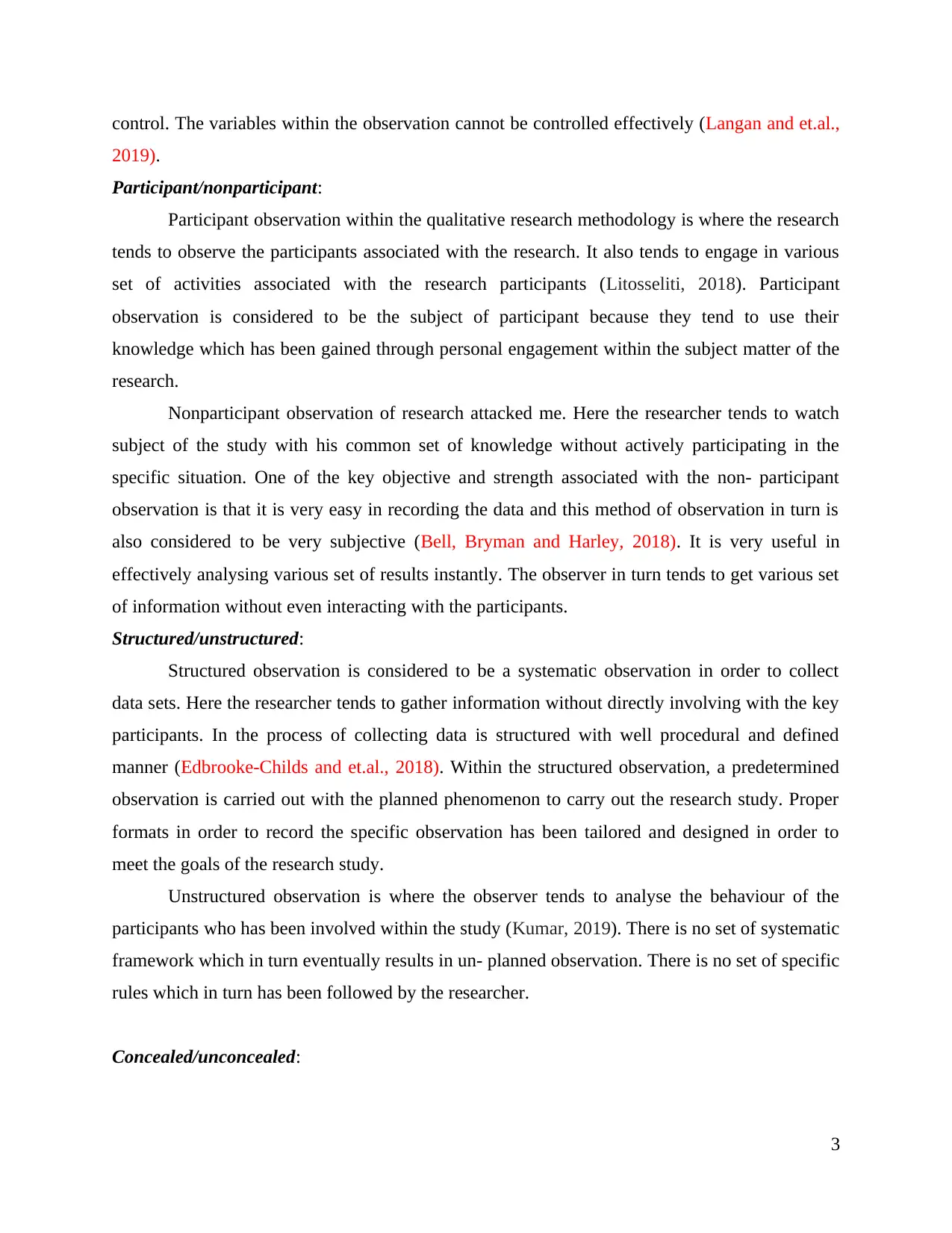
control. The variables within the observation cannot be controlled effectively (Langan and et.al.,
2019).
Participant/nonparticipant:
Participant observation within the qualitative research methodology is where the research
tends to observe the participants associated with the research. It also tends to engage in various
set of activities associated with the research participants (Litosseliti, 2018). Participant
observation is considered to be the subject of participant because they tend to use their
knowledge which has been gained through personal engagement within the subject matter of the
research.
Nonparticipant observation of research attacked me. Here the researcher tends to watch
subject of the study with his common set of knowledge without actively participating in the
specific situation. One of the key objective and strength associated with the non- participant
observation is that it is very easy in recording the data and this method of observation in turn is
also considered to be very subjective (Bell, Bryman and Harley, 2018). It is very useful in
effectively analysing various set of results instantly. The observer in turn tends to get various set
of information without even interacting with the participants.
Structured/unstructured:
Structured observation is considered to be a systematic observation in order to collect
data sets. Here the researcher tends to gather information without directly involving with the key
participants. In the process of collecting data is structured with well procedural and defined
manner (Edbrooke-Childs and et.al., 2018). Within the structured observation, a predetermined
observation is carried out with the planned phenomenon to carry out the research study. Proper
formats in order to record the specific observation has been tailored and designed in order to
meet the goals of the research study.
Unstructured observation is where the observer tends to analyse the behaviour of the
participants who has been involved within the study (Kumar, 2019). There is no set of systematic
framework which in turn eventually results in un- planned observation. There is no set of specific
rules which in turn has been followed by the researcher.
Concealed/unconcealed:
3
2019).
Participant/nonparticipant:
Participant observation within the qualitative research methodology is where the research
tends to observe the participants associated with the research. It also tends to engage in various
set of activities associated with the research participants (Litosseliti, 2018). Participant
observation is considered to be the subject of participant because they tend to use their
knowledge which has been gained through personal engagement within the subject matter of the
research.
Nonparticipant observation of research attacked me. Here the researcher tends to watch
subject of the study with his common set of knowledge without actively participating in the
specific situation. One of the key objective and strength associated with the non- participant
observation is that it is very easy in recording the data and this method of observation in turn is
also considered to be very subjective (Bell, Bryman and Harley, 2018). It is very useful in
effectively analysing various set of results instantly. The observer in turn tends to get various set
of information without even interacting with the participants.
Structured/unstructured:
Structured observation is considered to be a systematic observation in order to collect
data sets. Here the researcher tends to gather information without directly involving with the key
participants. In the process of collecting data is structured with well procedural and defined
manner (Edbrooke-Childs and et.al., 2018). Within the structured observation, a predetermined
observation is carried out with the planned phenomenon to carry out the research study. Proper
formats in order to record the specific observation has been tailored and designed in order to
meet the goals of the research study.
Unstructured observation is where the observer tends to analyse the behaviour of the
participants who has been involved within the study (Kumar, 2019). There is no set of systematic
framework which in turn eventually results in un- planned observation. There is no set of specific
rules which in turn has been followed by the researcher.
Concealed/unconcealed:
3
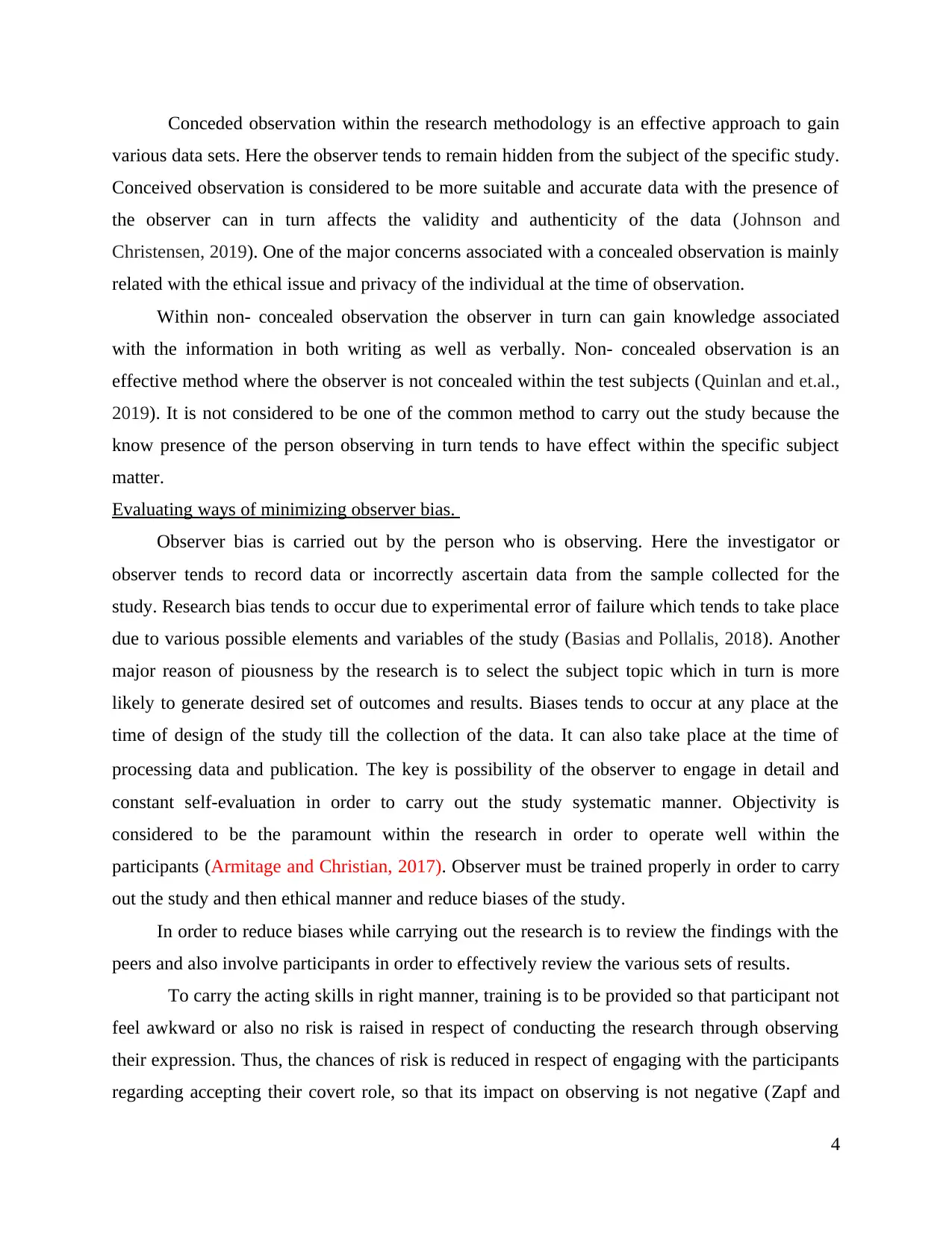
Conceded observation within the research methodology is an effective approach to gain
various data sets. Here the observer tends to remain hidden from the subject of the specific study.
Conceived observation is considered to be more suitable and accurate data with the presence of
the observer can in turn affects the validity and authenticity of the data (Johnson and
Christensen, 2019). One of the major concerns associated with a concealed observation is mainly
related with the ethical issue and privacy of the individual at the time of observation.
Within non- concealed observation the observer in turn can gain knowledge associated
with the information in both writing as well as verbally. Non- concealed observation is an
effective method where the observer is not concealed within the test subjects (Quinlan and et.al.,
2019). It is not considered to be one of the common method to carry out the study because the
know presence of the person observing in turn tends to have effect within the specific subject
matter.
Evaluating ways of minimizing observer bias.
Observer bias is carried out by the person who is observing. Here the investigator or
observer tends to record data or incorrectly ascertain data from the sample collected for the
study. Research bias tends to occur due to experimental error of failure which tends to take place
due to various possible elements and variables of the study (Basias and Pollalis, 2018). Another
major reason of piousness by the research is to select the subject topic which in turn is more
likely to generate desired set of outcomes and results. Biases tends to occur at any place at the
time of design of the study till the collection of the data. It can also take place at the time of
processing data and publication. The key is possibility of the observer to engage in detail and
constant self-evaluation in order to carry out the study systematic manner. Objectivity is
considered to be the paramount within the research in order to operate well within the
participants (Armitage and Christian, 2017). Observer must be trained properly in order to carry
out the study and then ethical manner and reduce biases of the study.
In order to reduce biases while carrying out the research is to review the findings with the
peers and also involve participants in order to effectively review the various sets of results.
To carry the acting skills in right manner, training is to be provided so that participant not
feel awkward or also no risk is raised in respect of conducting the research through observing
their expression. Thus, the chances of risk is reduced in respect of engaging with the participants
regarding accepting their covert role, so that its impact on observing is not negative (Zapf and
4
various data sets. Here the observer tends to remain hidden from the subject of the specific study.
Conceived observation is considered to be more suitable and accurate data with the presence of
the observer can in turn affects the validity and authenticity of the data (Johnson and
Christensen, 2019). One of the major concerns associated with a concealed observation is mainly
related with the ethical issue and privacy of the individual at the time of observation.
Within non- concealed observation the observer in turn can gain knowledge associated
with the information in both writing as well as verbally. Non- concealed observation is an
effective method where the observer is not concealed within the test subjects (Quinlan and et.al.,
2019). It is not considered to be one of the common method to carry out the study because the
know presence of the person observing in turn tends to have effect within the specific subject
matter.
Evaluating ways of minimizing observer bias.
Observer bias is carried out by the person who is observing. Here the investigator or
observer tends to record data or incorrectly ascertain data from the sample collected for the
study. Research bias tends to occur due to experimental error of failure which tends to take place
due to various possible elements and variables of the study (Basias and Pollalis, 2018). Another
major reason of piousness by the research is to select the subject topic which in turn is more
likely to generate desired set of outcomes and results. Biases tends to occur at any place at the
time of design of the study till the collection of the data. It can also take place at the time of
processing data and publication. The key is possibility of the observer to engage in detail and
constant self-evaluation in order to carry out the study systematic manner. Objectivity is
considered to be the paramount within the research in order to operate well within the
participants (Armitage and Christian, 2017). Observer must be trained properly in order to carry
out the study and then ethical manner and reduce biases of the study.
In order to reduce biases while carrying out the research is to review the findings with the
peers and also involve participants in order to effectively review the various sets of results.
To carry the acting skills in right manner, training is to be provided so that participant not
feel awkward or also no risk is raised in respect of conducting the research through observing
their expression. Thus, the chances of risk is reduced in respect of engaging with the participants
regarding accepting their covert role, so that its impact on observing is not negative (Zapf and
4
⊘ This is a preview!⊘
Do you want full access?
Subscribe today to unlock all pages.

Trusted by 1+ million students worldwide
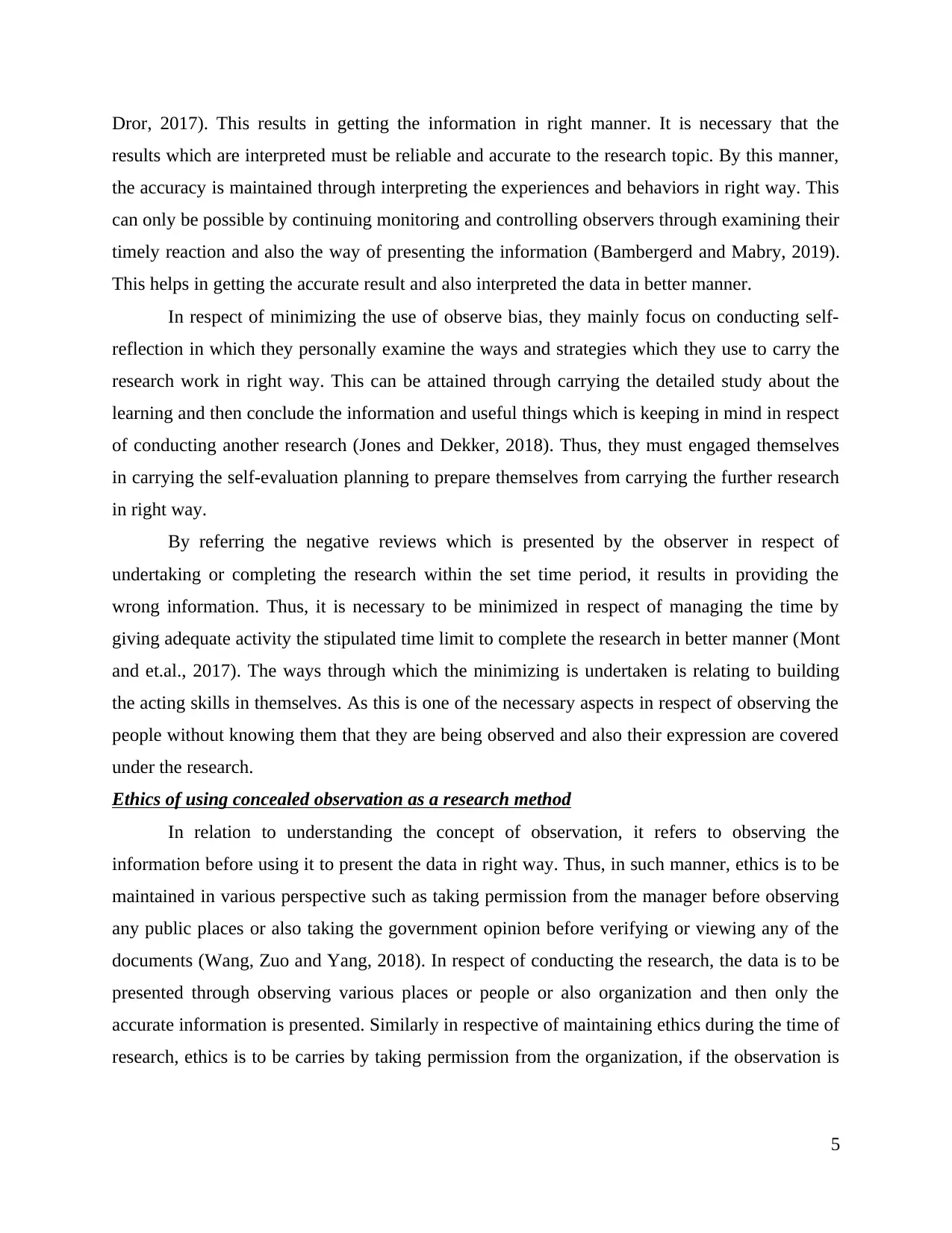
Dror, 2017). This results in getting the information in right manner. It is necessary that the
results which are interpreted must be reliable and accurate to the research topic. By this manner,
the accuracy is maintained through interpreting the experiences and behaviors in right way. This
can only be possible by continuing monitoring and controlling observers through examining their
timely reaction and also the way of presenting the information (Bambergerd and Mabry, 2019).
This helps in getting the accurate result and also interpreted the data in better manner.
In respect of minimizing the use of observe bias, they mainly focus on conducting self-
reflection in which they personally examine the ways and strategies which they use to carry the
research work in right way. This can be attained through carrying the detailed study about the
learning and then conclude the information and useful things which is keeping in mind in respect
of conducting another research (Jones and Dekker, 2018). Thus, they must engaged themselves
in carrying the self-evaluation planning to prepare themselves from carrying the further research
in right way.
By referring the negative reviews which is presented by the observer in respect of
undertaking or completing the research within the set time period, it results in providing the
wrong information. Thus, it is necessary to be minimized in respect of managing the time by
giving adequate activity the stipulated time limit to complete the research in better manner (Mont
and et.al., 2017). The ways through which the minimizing is undertaken is relating to building
the acting skills in themselves. As this is one of the necessary aspects in respect of observing the
people without knowing them that they are being observed and also their expression are covered
under the research.
Ethics of using concealed observation as a research method
In relation to understanding the concept of observation, it refers to observing the
information before using it to present the data in right way. Thus, in such manner, ethics is to be
maintained in various perspective such as taking permission from the manager before observing
any public places or also taking the government opinion before verifying or viewing any of the
documents (Wang, Zuo and Yang, 2018). In respect of conducting the research, the data is to be
presented through observing various places or people or also organization and then only the
accurate information is presented. Similarly in respective of maintaining ethics during the time of
research, ethics is to be carries by taking permission from the organization, if the observation is
5
results which are interpreted must be reliable and accurate to the research topic. By this manner,
the accuracy is maintained through interpreting the experiences and behaviors in right way. This
can only be possible by continuing monitoring and controlling observers through examining their
timely reaction and also the way of presenting the information (Bambergerd and Mabry, 2019).
This helps in getting the accurate result and also interpreted the data in better manner.
In respect of minimizing the use of observe bias, they mainly focus on conducting self-
reflection in which they personally examine the ways and strategies which they use to carry the
research work in right way. This can be attained through carrying the detailed study about the
learning and then conclude the information and useful things which is keeping in mind in respect
of conducting another research (Jones and Dekker, 2018). Thus, they must engaged themselves
in carrying the self-evaluation planning to prepare themselves from carrying the further research
in right way.
By referring the negative reviews which is presented by the observer in respect of
undertaking or completing the research within the set time period, it results in providing the
wrong information. Thus, it is necessary to be minimized in respect of managing the time by
giving adequate activity the stipulated time limit to complete the research in better manner (Mont
and et.al., 2017). The ways through which the minimizing is undertaken is relating to building
the acting skills in themselves. As this is one of the necessary aspects in respect of observing the
people without knowing them that they are being observed and also their expression are covered
under the research.
Ethics of using concealed observation as a research method
In relation to understanding the concept of observation, it refers to observing the
information before using it to present the data in right way. Thus, in such manner, ethics is to be
maintained in various perspective such as taking permission from the manager before observing
any public places or also taking the government opinion before verifying or viewing any of the
documents (Wang, Zuo and Yang, 2018). In respect of conducting the research, the data is to be
presented through observing various places or people or also organization and then only the
accurate information is presented. Similarly in respective of maintaining ethics during the time of
research, ethics is to be carries by taking permission from the organization, if the observation is
5
Paraphrase This Document
Need a fresh take? Get an instant paraphrase of this document with our AI Paraphraser
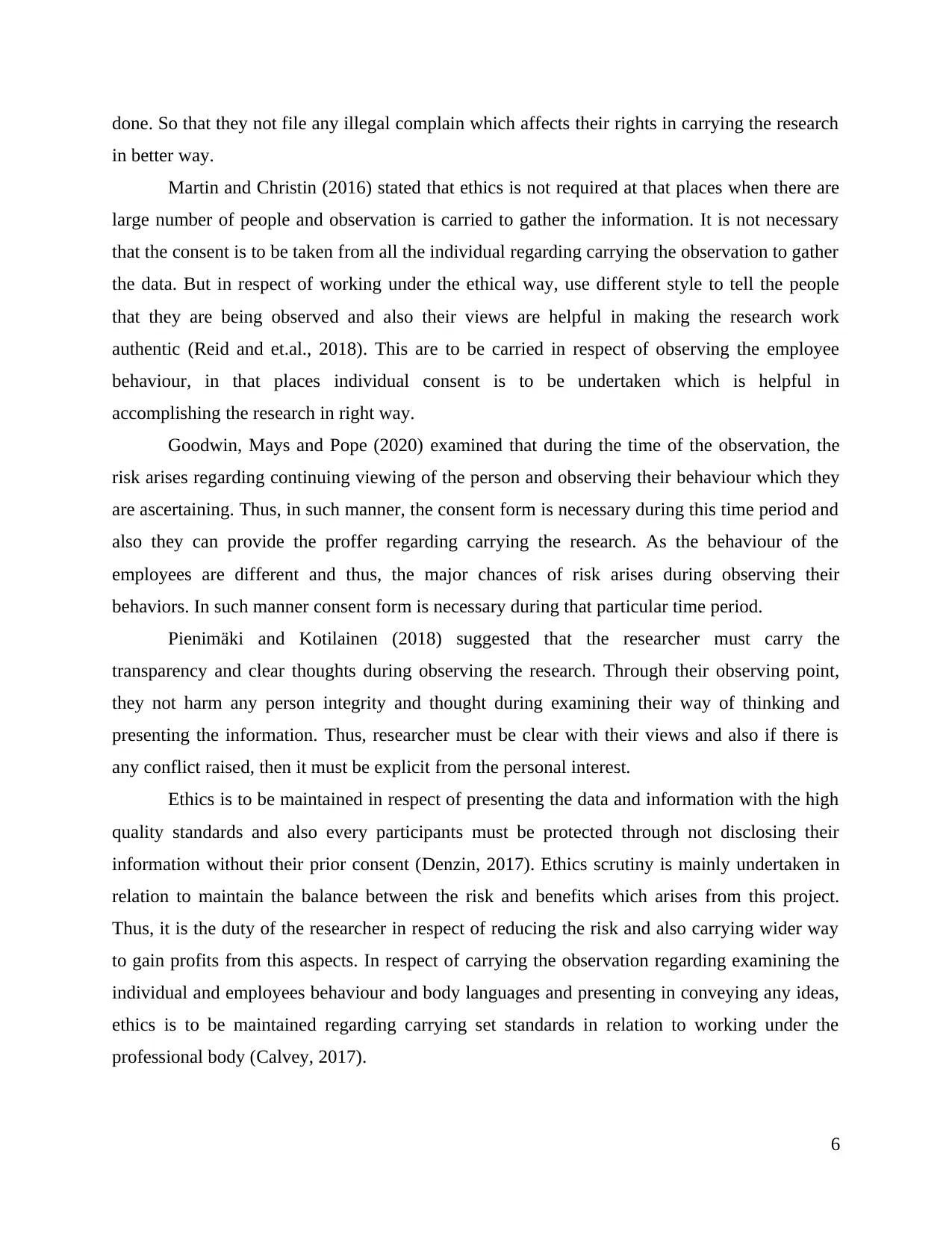
done. So that they not file any illegal complain which affects their rights in carrying the research
in better way.
Martin and Christin (2016) stated that ethics is not required at that places when there are
large number of people and observation is carried to gather the information. It is not necessary
that the consent is to be taken from all the individual regarding carrying the observation to gather
the data. But in respect of working under the ethical way, use different style to tell the people
that they are being observed and also their views are helpful in making the research work
authentic (Reid and et.al., 2018). This are to be carried in respect of observing the employee
behaviour, in that places individual consent is to be undertaken which is helpful in
accomplishing the research in right way.
Goodwin, Mays and Pope (2020) examined that during the time of the observation, the
risk arises regarding continuing viewing of the person and observing their behaviour which they
are ascertaining. Thus, in such manner, the consent form is necessary during this time period and
also they can provide the proffer regarding carrying the research. As the behaviour of the
employees are different and thus, the major chances of risk arises during observing their
behaviors. In such manner consent form is necessary during that particular time period.
Pienimäki and Kotilainen (2018) suggested that the researcher must carry the
transparency and clear thoughts during observing the research. Through their observing point,
they not harm any person integrity and thought during examining their way of thinking and
presenting the information. Thus, researcher must be clear with their views and also if there is
any conflict raised, then it must be explicit from the personal interest.
Ethics is to be maintained in respect of presenting the data and information with the high
quality standards and also every participants must be protected through not disclosing their
information without their prior consent (Denzin, 2017). Ethics scrutiny is mainly undertaken in
relation to maintain the balance between the risk and benefits which arises from this project.
Thus, it is the duty of the researcher in respect of reducing the risk and also carrying wider way
to gain profits from this aspects. In respect of carrying the observation regarding examining the
individual and employees behaviour and body languages and presenting in conveying any ideas,
ethics is to be maintained regarding carrying set standards in relation to working under the
professional body (Calvey, 2017).
6
in better way.
Martin and Christin (2016) stated that ethics is not required at that places when there are
large number of people and observation is carried to gather the information. It is not necessary
that the consent is to be taken from all the individual regarding carrying the observation to gather
the data. But in respect of working under the ethical way, use different style to tell the people
that they are being observed and also their views are helpful in making the research work
authentic (Reid and et.al., 2018). This are to be carried in respect of observing the employee
behaviour, in that places individual consent is to be undertaken which is helpful in
accomplishing the research in right way.
Goodwin, Mays and Pope (2020) examined that during the time of the observation, the
risk arises regarding continuing viewing of the person and observing their behaviour which they
are ascertaining. Thus, in such manner, the consent form is necessary during this time period and
also they can provide the proffer regarding carrying the research. As the behaviour of the
employees are different and thus, the major chances of risk arises during observing their
behaviors. In such manner consent form is necessary during that particular time period.
Pienimäki and Kotilainen (2018) suggested that the researcher must carry the
transparency and clear thoughts during observing the research. Through their observing point,
they not harm any person integrity and thought during examining their way of thinking and
presenting the information. Thus, researcher must be clear with their views and also if there is
any conflict raised, then it must be explicit from the personal interest.
Ethics is to be maintained in respect of presenting the data and information with the high
quality standards and also every participants must be protected through not disclosing their
information without their prior consent (Denzin, 2017). Ethics scrutiny is mainly undertaken in
relation to maintain the balance between the risk and benefits which arises from this project.
Thus, it is the duty of the researcher in respect of reducing the risk and also carrying wider way
to gain profits from this aspects. In respect of carrying the observation regarding examining the
individual and employees behaviour and body languages and presenting in conveying any ideas,
ethics is to be maintained regarding carrying set standards in relation to working under the
professional body (Calvey, 2017).
6
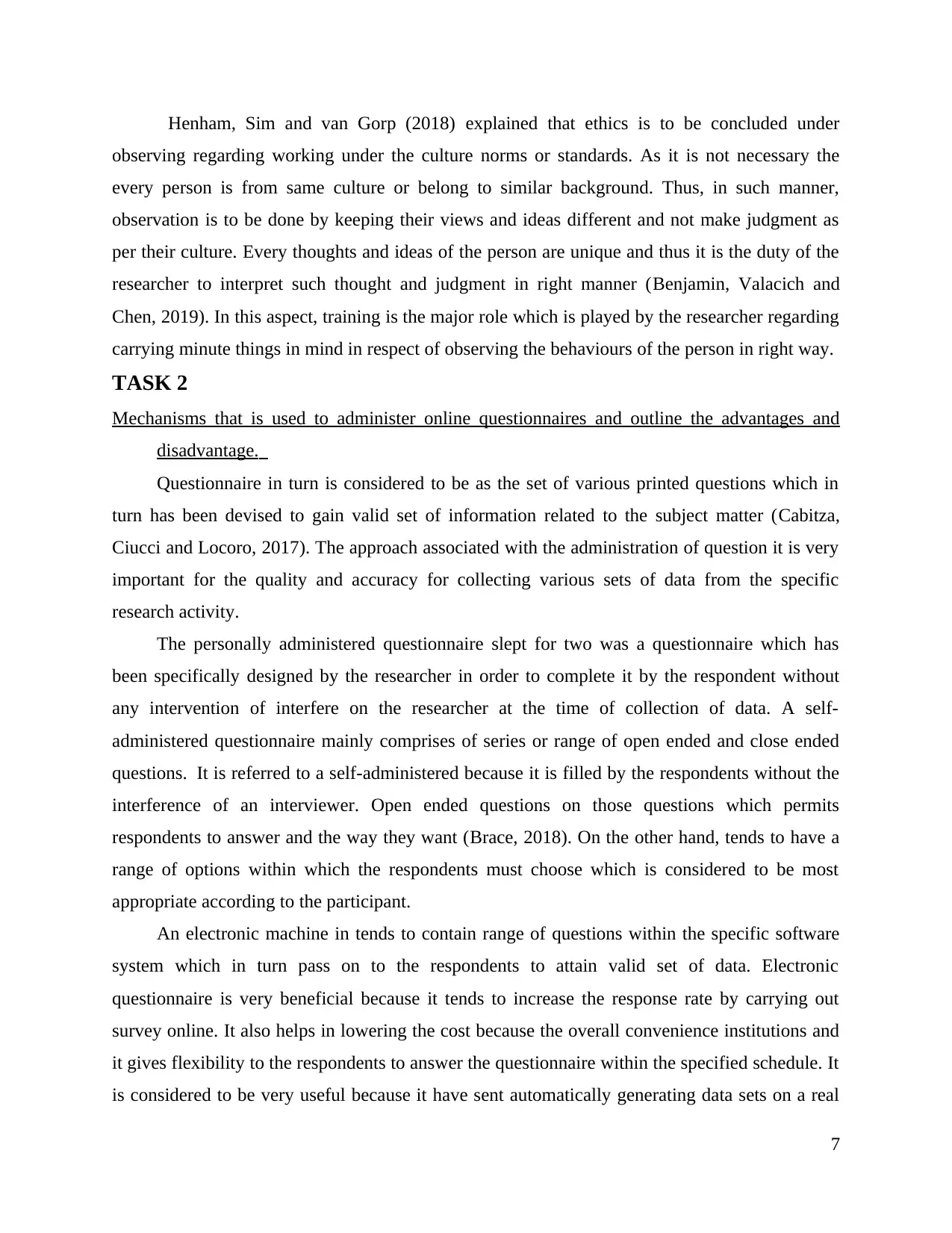
Henham, Sim and van Gorp (2018) explained that ethics is to be concluded under
observing regarding working under the culture norms or standards. As it is not necessary the
every person is from same culture or belong to similar background. Thus, in such manner,
observation is to be done by keeping their views and ideas different and not make judgment as
per their culture. Every thoughts and ideas of the person are unique and thus it is the duty of the
researcher to interpret such thought and judgment in right manner (Benjamin, Valacich and
Chen, 2019). In this aspect, training is the major role which is played by the researcher regarding
carrying minute things in mind in respect of observing the behaviours of the person in right way.
TASK 2
Mechanisms that is used to administer online questionnaires and outline the advantages and
disadvantage.
Questionnaire in turn is considered to be as the set of various printed questions which in
turn has been devised to gain valid set of information related to the subject matter (Cabitza,
Ciucci and Locoro, 2017). The approach associated with the administration of question it is very
important for the quality and accuracy for collecting various sets of data from the specific
research activity.
The personally administered questionnaire slept for two was a questionnaire which has
been specifically designed by the researcher in order to complete it by the respondent without
any intervention of interfere on the researcher at the time of collection of data. A self-
administered questionnaire mainly comprises of series or range of open ended and close ended
questions. It is referred to a self-administered because it is filled by the respondents without the
interference of an interviewer. Open ended questions on those questions which permits
respondents to answer and the way they want (Brace, 2018). On the other hand, tends to have a
range of options within which the respondents must choose which is considered to be most
appropriate according to the participant.
An electronic machine in tends to contain range of questions within the specific software
system which in turn pass on to the respondents to attain valid set of data. Electronic
questionnaire is very beneficial because it tends to increase the response rate by carrying out
survey online. It also helps in lowering the cost because the overall convenience institutions and
it gives flexibility to the respondents to answer the questionnaire within the specified schedule. It
is considered to be very useful because it have sent automatically generating data sets on a real
7
observing regarding working under the culture norms or standards. As it is not necessary the
every person is from same culture or belong to similar background. Thus, in such manner,
observation is to be done by keeping their views and ideas different and not make judgment as
per their culture. Every thoughts and ideas of the person are unique and thus it is the duty of the
researcher to interpret such thought and judgment in right manner (Benjamin, Valacich and
Chen, 2019). In this aspect, training is the major role which is played by the researcher regarding
carrying minute things in mind in respect of observing the behaviours of the person in right way.
TASK 2
Mechanisms that is used to administer online questionnaires and outline the advantages and
disadvantage.
Questionnaire in turn is considered to be as the set of various printed questions which in
turn has been devised to gain valid set of information related to the subject matter (Cabitza,
Ciucci and Locoro, 2017). The approach associated with the administration of question it is very
important for the quality and accuracy for collecting various sets of data from the specific
research activity.
The personally administered questionnaire slept for two was a questionnaire which has
been specifically designed by the researcher in order to complete it by the respondent without
any intervention of interfere on the researcher at the time of collection of data. A self-
administered questionnaire mainly comprises of series or range of open ended and close ended
questions. It is referred to a self-administered because it is filled by the respondents without the
interference of an interviewer. Open ended questions on those questions which permits
respondents to answer and the way they want (Brace, 2018). On the other hand, tends to have a
range of options within which the respondents must choose which is considered to be most
appropriate according to the participant.
An electronic machine in tends to contain range of questions within the specific software
system which in turn pass on to the respondents to attain valid set of data. Electronic
questionnaire is very beneficial because it tends to increase the response rate by carrying out
survey online. It also helps in lowering the cost because the overall convenience institutions and
it gives flexibility to the respondents to answer the questionnaire within the specified schedule. It
is considered to be very useful because it have sent automatically generating data sets on a real
7
⊘ This is a preview!⊘
Do you want full access?
Subscribe today to unlock all pages.

Trusted by 1+ million students worldwide
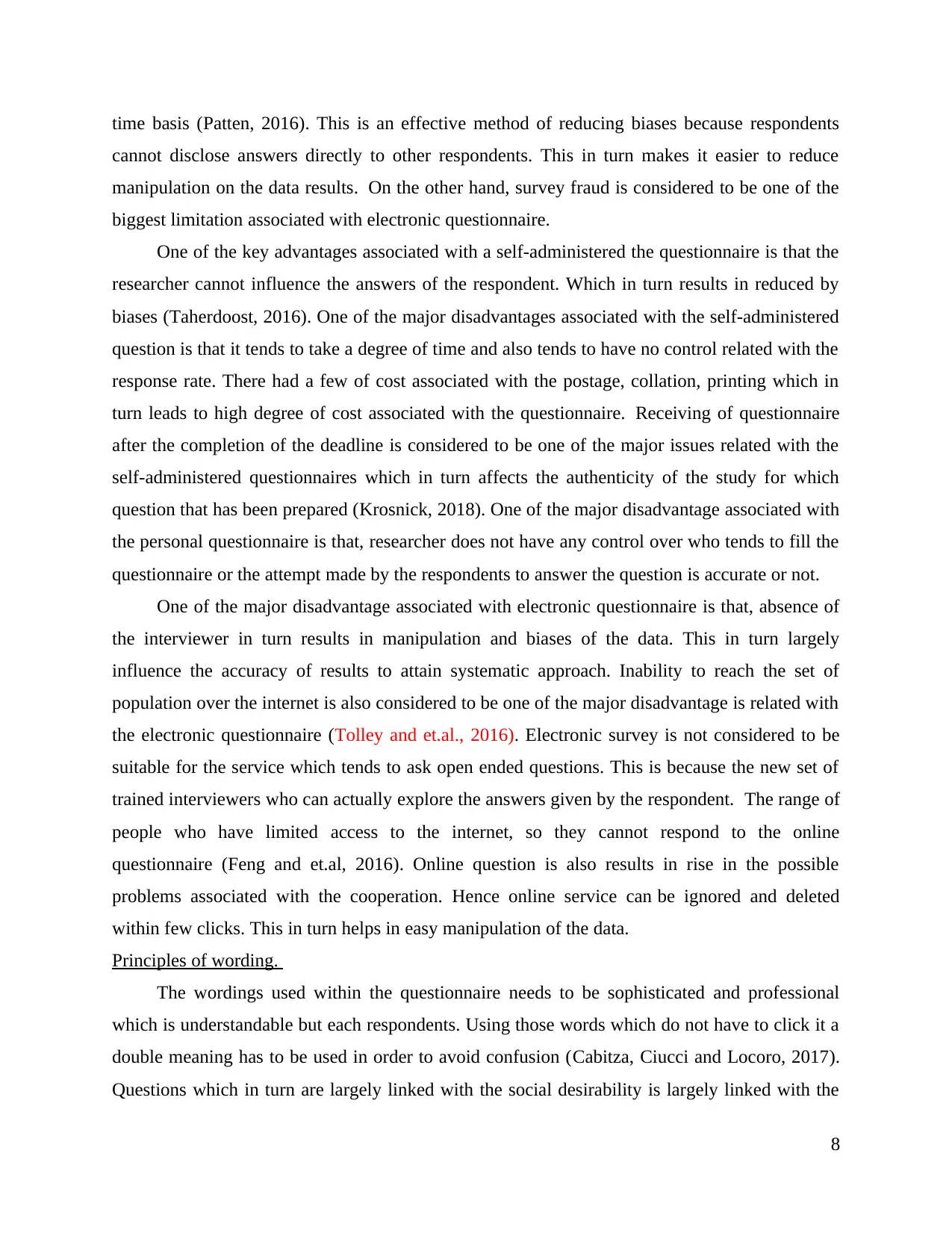
time basis (Patten, 2016). This is an effective method of reducing biases because respondents
cannot disclose answers directly to other respondents. This in turn makes it easier to reduce
manipulation on the data results. On the other hand, survey fraud is considered to be one of the
biggest limitation associated with electronic questionnaire.
One of the key advantages associated with a self-administered the questionnaire is that the
researcher cannot influence the answers of the respondent. Which in turn results in reduced by
biases (Taherdoost, 2016). One of the major disadvantages associated with the self-administered
question is that it tends to take a degree of time and also tends to have no control related with the
response rate. There had a few of cost associated with the postage, collation, printing which in
turn leads to high degree of cost associated with the questionnaire. Receiving of questionnaire
after the completion of the deadline is considered to be one of the major issues related with the
self-administered questionnaires which in turn affects the authenticity of the study for which
question that has been prepared (Krosnick, 2018). One of the major disadvantage associated with
the personal questionnaire is that, researcher does not have any control over who tends to fill the
questionnaire or the attempt made by the respondents to answer the question is accurate or not.
One of the major disadvantage associated with electronic questionnaire is that, absence of
the interviewer in turn results in manipulation and biases of the data. This in turn largely
influence the accuracy of results to attain systematic approach. Inability to reach the set of
population over the internet is also considered to be one of the major disadvantage is related with
the electronic questionnaire (Tolley and et.al., 2016). Electronic survey is not considered to be
suitable for the service which tends to ask open ended questions. This is because the new set of
trained interviewers who can actually explore the answers given by the respondent. The range of
people who have limited access to the internet, so they cannot respond to the online
questionnaire (Feng and et.al, 2016). Online question is also results in rise in the possible
problems associated with the cooperation. Hence online service can be ignored and deleted
within few clicks. This in turn helps in easy manipulation of the data.
Principles of wording.
The wordings used within the questionnaire needs to be sophisticated and professional
which is understandable but each respondents. Using those words which do not have to click it a
double meaning has to be used in order to avoid confusion (Cabitza, Ciucci and Locoro, 2017).
Questions which in turn are largely linked with the social desirability is largely linked with the
8
cannot disclose answers directly to other respondents. This in turn makes it easier to reduce
manipulation on the data results. On the other hand, survey fraud is considered to be one of the
biggest limitation associated with electronic questionnaire.
One of the key advantages associated with a self-administered the questionnaire is that the
researcher cannot influence the answers of the respondent. Which in turn results in reduced by
biases (Taherdoost, 2016). One of the major disadvantages associated with the self-administered
question is that it tends to take a degree of time and also tends to have no control related with the
response rate. There had a few of cost associated with the postage, collation, printing which in
turn leads to high degree of cost associated with the questionnaire. Receiving of questionnaire
after the completion of the deadline is considered to be one of the major issues related with the
self-administered questionnaires which in turn affects the authenticity of the study for which
question that has been prepared (Krosnick, 2018). One of the major disadvantage associated with
the personal questionnaire is that, researcher does not have any control over who tends to fill the
questionnaire or the attempt made by the respondents to answer the question is accurate or not.
One of the major disadvantage associated with electronic questionnaire is that, absence of
the interviewer in turn results in manipulation and biases of the data. This in turn largely
influence the accuracy of results to attain systematic approach. Inability to reach the set of
population over the internet is also considered to be one of the major disadvantage is related with
the electronic questionnaire (Tolley and et.al., 2016). Electronic survey is not considered to be
suitable for the service which tends to ask open ended questions. This is because the new set of
trained interviewers who can actually explore the answers given by the respondent. The range of
people who have limited access to the internet, so they cannot respond to the online
questionnaire (Feng and et.al, 2016). Online question is also results in rise in the possible
problems associated with the cooperation. Hence online service can be ignored and deleted
within few clicks. This in turn helps in easy manipulation of the data.
Principles of wording.
The wordings used within the questionnaire needs to be sophisticated and professional
which is understandable but each respondents. Using those words which do not have to click it a
double meaning has to be used in order to avoid confusion (Cabitza, Ciucci and Locoro, 2017).
Questions which in turn are largely linked with the social desirability is largely linked with the
8
Paraphrase This Document
Need a fresh take? Get an instant paraphrase of this document with our AI Paraphraser
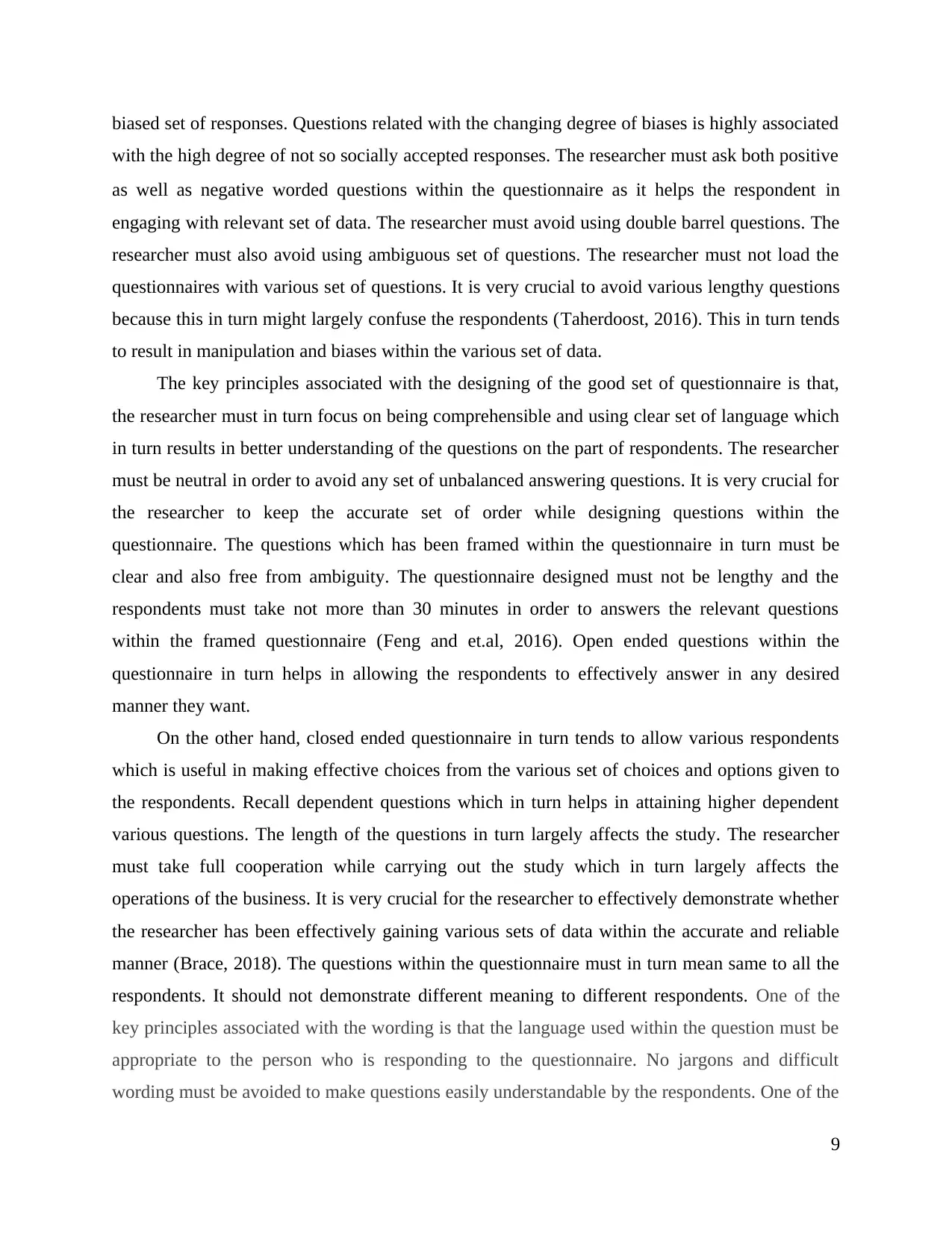
biased set of responses. Questions related with the changing degree of biases is highly associated
with the high degree of not so socially accepted responses. The researcher must ask both positive
as well as negative worded questions within the questionnaire as it helps the respondent in
engaging with relevant set of data. The researcher must avoid using double barrel questions. The
researcher must also avoid using ambiguous set of questions. The researcher must not load the
questionnaires with various set of questions. It is very crucial to avoid various lengthy questions
because this in turn might largely confuse the respondents (Taherdoost, 2016). This in turn tends
to result in manipulation and biases within the various set of data.
The key principles associated with the designing of the good set of questionnaire is that,
the researcher must in turn focus on being comprehensible and using clear set of language which
in turn results in better understanding of the questions on the part of respondents. The researcher
must be neutral in order to avoid any set of unbalanced answering questions. It is very crucial for
the researcher to keep the accurate set of order while designing questions within the
questionnaire. The questions which has been framed within the questionnaire in turn must be
clear and also free from ambiguity. The questionnaire designed must not be lengthy and the
respondents must take not more than 30 minutes in order to answers the relevant questions
within the framed questionnaire (Feng and et.al, 2016). Open ended questions within the
questionnaire in turn helps in allowing the respondents to effectively answer in any desired
manner they want.
On the other hand, closed ended questionnaire in turn tends to allow various respondents
which is useful in making effective choices from the various set of choices and options given to
the respondents. Recall dependent questions which in turn helps in attaining higher dependent
various questions. The length of the questions in turn largely affects the study. The researcher
must take full cooperation while carrying out the study which in turn largely affects the
operations of the business. It is very crucial for the researcher to effectively demonstrate whether
the researcher has been effectively gaining various sets of data within the accurate and reliable
manner (Brace, 2018). The questions within the questionnaire must in turn mean same to all the
respondents. It should not demonstrate different meaning to different respondents. One of the
key principles associated with the wording is that the language used within the question must be
appropriate to the person who is responding to the questionnaire. No jargons and difficult
wording must be avoided to make questions easily understandable by the respondents. One of the
9
with the high degree of not so socially accepted responses. The researcher must ask both positive
as well as negative worded questions within the questionnaire as it helps the respondent in
engaging with relevant set of data. The researcher must avoid using double barrel questions. The
researcher must also avoid using ambiguous set of questions. The researcher must not load the
questionnaires with various set of questions. It is very crucial to avoid various lengthy questions
because this in turn might largely confuse the respondents (Taherdoost, 2016). This in turn tends
to result in manipulation and biases within the various set of data.
The key principles associated with the designing of the good set of questionnaire is that,
the researcher must in turn focus on being comprehensible and using clear set of language which
in turn results in better understanding of the questions on the part of respondents. The researcher
must be neutral in order to avoid any set of unbalanced answering questions. It is very crucial for
the researcher to keep the accurate set of order while designing questions within the
questionnaire. The questions which has been framed within the questionnaire in turn must be
clear and also free from ambiguity. The questionnaire designed must not be lengthy and the
respondents must take not more than 30 minutes in order to answers the relevant questions
within the framed questionnaire (Feng and et.al, 2016). Open ended questions within the
questionnaire in turn helps in allowing the respondents to effectively answer in any desired
manner they want.
On the other hand, closed ended questionnaire in turn tends to allow various respondents
which is useful in making effective choices from the various set of choices and options given to
the respondents. Recall dependent questions which in turn helps in attaining higher dependent
various questions. The length of the questions in turn largely affects the study. The researcher
must take full cooperation while carrying out the study which in turn largely affects the
operations of the business. It is very crucial for the researcher to effectively demonstrate whether
the researcher has been effectively gaining various sets of data within the accurate and reliable
manner (Brace, 2018). The questions within the questionnaire must in turn mean same to all the
respondents. It should not demonstrate different meaning to different respondents. One of the
key principles associated with the wording is that the language used within the question must be
appropriate to the person who is responding to the questionnaire. No jargons and difficult
wording must be avoided to make questions easily understandable by the respondents. One of the
9
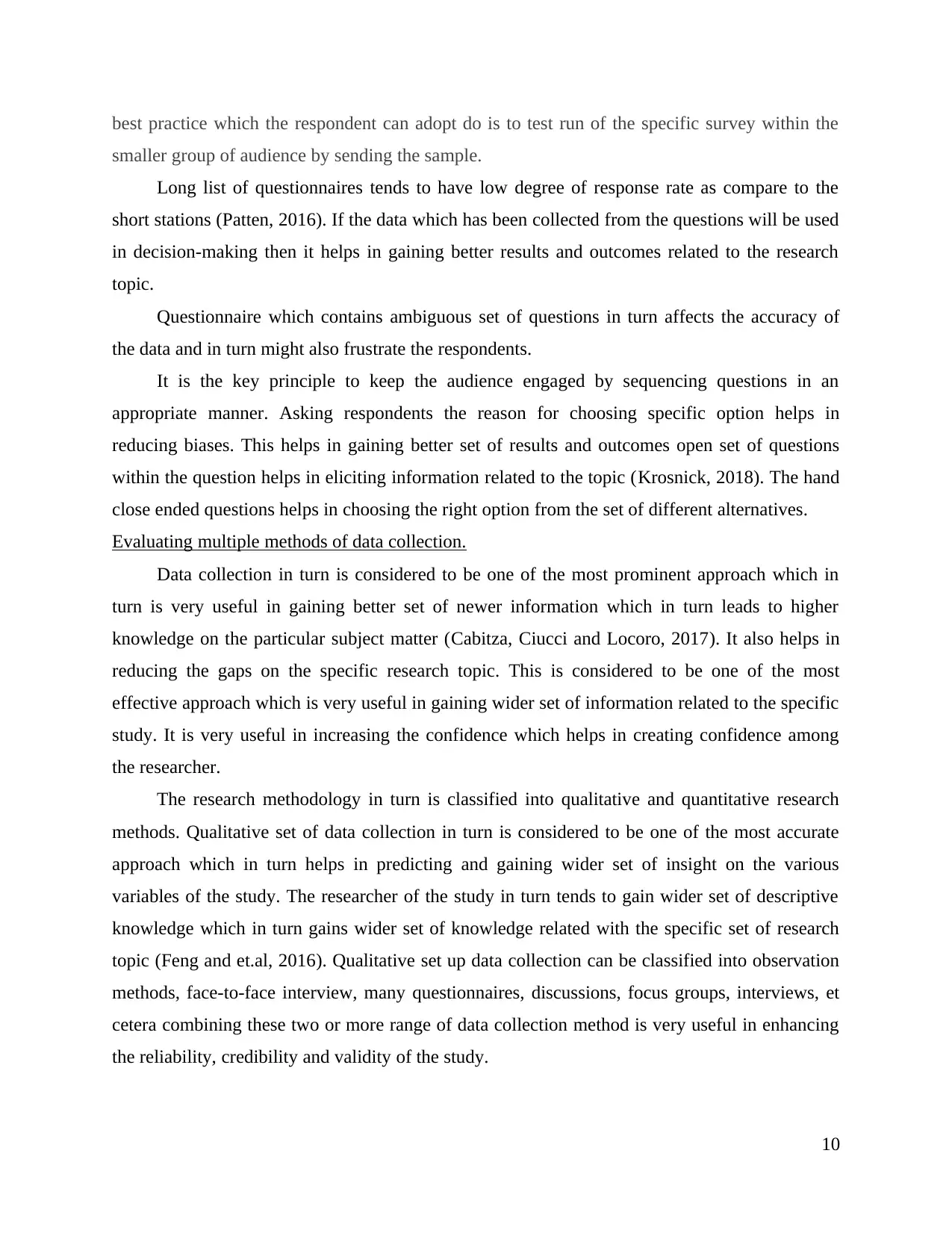
best practice which the respondent can adopt do is to test run of the specific survey within the
smaller group of audience by sending the sample.
Long list of questionnaires tends to have low degree of response rate as compare to the
short stations (Patten, 2016). If the data which has been collected from the questions will be used
in decision-making then it helps in gaining better results and outcomes related to the research
topic.
Questionnaire which contains ambiguous set of questions in turn affects the accuracy of
the data and in turn might also frustrate the respondents.
It is the key principle to keep the audience engaged by sequencing questions in an
appropriate manner. Asking respondents the reason for choosing specific option helps in
reducing biases. This helps in gaining better set of results and outcomes open set of questions
within the question helps in eliciting information related to the topic (Krosnick, 2018). The hand
close ended questions helps in choosing the right option from the set of different alternatives.
Evaluating multiple methods of data collection.
Data collection in turn is considered to be one of the most prominent approach which in
turn is very useful in gaining better set of newer information which in turn leads to higher
knowledge on the particular subject matter (Cabitza, Ciucci and Locoro, 2017). It also helps in
reducing the gaps on the specific research topic. This is considered to be one of the most
effective approach which is very useful in gaining wider set of information related to the specific
study. It is very useful in increasing the confidence which helps in creating confidence among
the researcher.
The research methodology in turn is classified into qualitative and quantitative research
methods. Qualitative set of data collection in turn is considered to be one of the most accurate
approach which in turn helps in predicting and gaining wider set of insight on the various
variables of the study. The researcher of the study in turn tends to gain wider set of descriptive
knowledge which in turn gains wider set of knowledge related with the specific set of research
topic (Feng and et.al, 2016). Qualitative set up data collection can be classified into observation
methods, face-to-face interview, many questionnaires, discussions, focus groups, interviews, et
cetera combining these two or more range of data collection method is very useful in enhancing
the reliability, credibility and validity of the study.
10
smaller group of audience by sending the sample.
Long list of questionnaires tends to have low degree of response rate as compare to the
short stations (Patten, 2016). If the data which has been collected from the questions will be used
in decision-making then it helps in gaining better results and outcomes related to the research
topic.
Questionnaire which contains ambiguous set of questions in turn affects the accuracy of
the data and in turn might also frustrate the respondents.
It is the key principle to keep the audience engaged by sequencing questions in an
appropriate manner. Asking respondents the reason for choosing specific option helps in
reducing biases. This helps in gaining better set of results and outcomes open set of questions
within the question helps in eliciting information related to the topic (Krosnick, 2018). The hand
close ended questions helps in choosing the right option from the set of different alternatives.
Evaluating multiple methods of data collection.
Data collection in turn is considered to be one of the most prominent approach which in
turn is very useful in gaining better set of newer information which in turn leads to higher
knowledge on the particular subject matter (Cabitza, Ciucci and Locoro, 2017). It also helps in
reducing the gaps on the specific research topic. This is considered to be one of the most
effective approach which is very useful in gaining wider set of information related to the specific
study. It is very useful in increasing the confidence which helps in creating confidence among
the researcher.
The research methodology in turn is classified into qualitative and quantitative research
methods. Qualitative set of data collection in turn is considered to be one of the most accurate
approach which in turn helps in predicting and gaining wider set of insight on the various
variables of the study. The researcher of the study in turn tends to gain wider set of descriptive
knowledge which in turn gains wider set of knowledge related with the specific set of research
topic (Feng and et.al, 2016). Qualitative set up data collection can be classified into observation
methods, face-to-face interview, many questionnaires, discussions, focus groups, interviews, et
cetera combining these two or more range of data collection method is very useful in enhancing
the reliability, credibility and validity of the study.
10
⊘ This is a preview!⊘
Do you want full access?
Subscribe today to unlock all pages.

Trusted by 1+ million students worldwide
1 out of 16
Related Documents
Your All-in-One AI-Powered Toolkit for Academic Success.
+13062052269
info@desklib.com
Available 24*7 on WhatsApp / Email
![[object Object]](/_next/static/media/star-bottom.7253800d.svg)
Unlock your academic potential
Copyright © 2020–2025 A2Z Services. All Rights Reserved. Developed and managed by ZUCOL.





